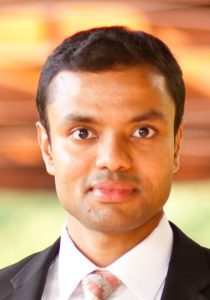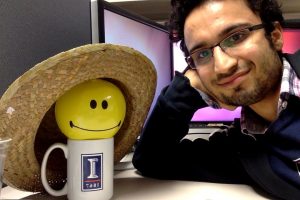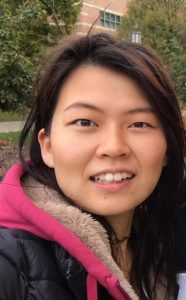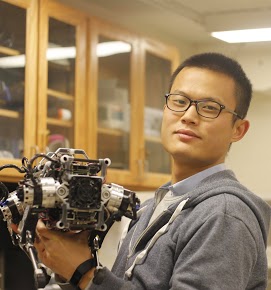One of the major areas of research in the Coordinated Science Laboratory is control. In fact CSL was originally named “Control Systems Laboratory” when it was founded in 1951. From then on, CSL has become one of the leading research centers in the field of control (Ranked 2nd worldwide). This great success is due to the CSL’s unique collaborative environment that promotes interdisciplinary research.
The Decision and Control session in CSL Student Conference provides an opportunity for researchers in this area to gather and discuss the latest advances in the field of control. The session includes a keynote lecture by a distinguished speaker followed by several student talks presenting their current research. We invite students across ALL majors to present their work in the areas related to (but not limited to) control theory, optimization, game theory, and robotics.
Time and place – Thursday Feb. 7, 2pm-5pm, CSL B02
Keynote Speaker: Shreyas Sundaram – Purdue University

Resilient Distributed State Estimation of Dynamical Systems
Summary – Applications in environmental monitoring, surveillance, and industrial control require a network of (mobile) agents to collectively estimate the state of a dynamical process evolving over a region. However, these networks of mobile agents also introduce various challenges for distributed state estimation, including intermittent observations of the dynamical process, loss of communication links due to mobility and packet drops, and the potential for malicious or faulty behavior by some of the agents. In this work, we develop a resilient, fully-distributed, and provably correct state estimation algorithm that simultaneously accounts for each of the above considerations, and in turn, offers a general framework for reasoning about distributed state estimation problems in dynamic and adversarial environments. Our approach revolves around a resilient filtering technique for dealing with worst-case adversarial behavior, and is capable of tolerating a potentially large number of compromised nodes. We identify conditions on the dynamical system, the network topology (induced by the communication patterns between the agents), and the attack/failure models that guarantee applicability of our proposed techniques.
Bio – Shreyas Sundaram is an Associate Professor in the School of Electrical and Computer Engineering at Purdue University. He received his Ph.D. in Electrical Engineering from the University of Illinois at Urbana-Champaign in 2009, and was a Postdoctoral Researcher at the University of Pennsylvania from 2009 to 2010. He was an Assistant Professor at the University of Waterloo from 2010 to 2014. His research interests include network science, large-scale dynamical systems, fault-tolerant and secure control, game theory, linear system and estimation theory, and the application of algebraic graph theory to system analysis. Dr. Sundaram is a recipient of the NSF CAREER award, and an Air Force Research Lab Summer Faculty Fellowship. At Purdue, he received the Hesselberth Award for Teaching Excellence, and the Ruth and Joel Spira Outstanding Teacher Award. At Waterloo, he received the Department of Electrical and Computer Engineering Research Award in 2014, the University of Waterloo Outstanding Performance Award in 2013 and the Faculty of Engineering Distinguished Performance Award in 2012. He received the M. E. Van Valkenburg Graduate Research Award and the Robert T. Chien Memorial Award from the University of Illinois, both for excellence in graduate research, and he was a finalist for the Best Student Paper Award at the 2007 and 2008 American Control Conferences.
Omer Tanovic – MIT

Causally Stable Approximation of Optimal Maps in Infinite-Dimensional Supremum Norm Constrained Least-Squares Optimization
Summary – A number of tasks in modern digital communications, e.g., envelope tracking or peak-to-average-power ratio (PAPR) reduction of RF signals, can be considered as a problem of designing discrete-time systems which are optimal in frequency-weighted least squares sense subject to a maximal output amplitude constraint. Unfortunately, in such problems, the optimality conditions do not provide an explicit way of generating the optimal output as a real-time implementable transformation of the input, due to causal instability of the resulting dynamical equations and sequential nature in which the criterion function is revealed over time.
In this talk, we first show that the optimal system has exponentially fading memory, which suggests existence of arbitrarily good receding horizon (i.e., finite latency) approximations. We propose a real-time realizable algorithm which, under an L1 dominance assumption about the equation coefficients, returns high-quality approximations to the optimal map, where the approximation quality is measured in terms of the supremum norm of the error signal. The algorithm exploits the optimality conditions and is realized as a causally stable nonlinear discrete-time system, which is allowed to look ahead at the input signal over a finite horizon (and is, therefore, of finite latency). Furthermore, we propose an extension of the well-known method of balanced truncation for linear systems to the class of nonlinear models with weakly contractive operators. This results is then used to derive a causally stable finite-latency nonlinear system which also returns high-quality approximations to the optimal map, where the approximation quality is now measured in terms of the L2 gain of the error system. In this case, the algorithm does not depend on any special assumptions about the least squares criterion function (e.g., no L1 dominance).
Bio – Omer Tanovic is a Ph.D. Candidate in the Electrical Engineering and Computer Science Department at MIT. He received Dipl. Ing. degree and M.Sc. degree in electrical engineering and computer science from the University of Sarajevo, Bosnia-Herzegovina, in 2007 and 2011. From 2007-2011 he was with the EECS Department at University of Sarajevo, as a Teaching Assistant and Instructor. He has held multiple part-time and internship positions in industry, with Bosna-S Oil Services Company, Shell Global Solutions US, Schlumberger-Doll Research and Mitsubishi Electric Research Labs. His research interests include nonlinear systems analysis, control and design, algorithms for linearization and performance enhancement of RF circuits, and applications of optimization in communications, signal processing and systems theory. Omer was the Secretary of the IEEE Bosnia-Herzegovina Section (2011-2012) and the Chair of the IEEE B&H Young Professionals (formerly GOLD) Affinity Group (2007-2011). He was the recipient of Golden Ring of the Faculty of Electrical Engineering Award from the EECS Department at University of Sarajevo, the Carlton E. Tucker Teaching Award from the EECS Department at MIT, and the Graduate Student Extraordinary Teaching and Mentoring Award from the MIT School of Engineering.
Amirhossein Taghvaei – UIUC

Accelerated flow for probability distributions through mean-field optimal control
Summary – This talk is concerned with methodology and numerical algorithms for constructing accelerated gradient flows on the space of probability distributions. In particular, we extend the recent variational formulation of accelerated gradient methods in (Wibisono2016) from vector valued variables to probability distributions. The variational problem is modeled as a mean-field optimal control problem. The maximum principle of optimal control theory is used to derive Hamilton’s equations for the optimal gradient flow. The Hamilton’s equation are shown to achieve the accelerated form of density transport from any initial probability distribution to a target probability distribution. A quantitative estimate on the asymptotic convergence rate is provided based on a Lyapunov function construction, when the objective functional is displacement convex. Two numerical approximations are presented to implement the Hamilton’s equations as a system of $N$ interacting particles. The continuous limit of the Nesterov’s algorithm is shown to be a special case with $N=1$. The algorithm is illustrated with numerical examples and the performance is compared with the MCMC and Hamiltonian MCMC algorithms.
Bio – Amirhossein Taghvaei was born and raised in southern beach of Caspian sea, Mazandaran, Iran. After obtaining two B.S degrees in Mechanical engineering and Physics from Sharif Univ. of Technology, Tehran, Iran, he joined University of Illinois at Urbana-Champaign as a PhD student in Mechanical Science and Engineering department. While pursuing PhD, he obtained his Masters degree in Mathematics, in May 2017. He is now in the last stage of his PhD program looking for opportunities to continue an academic path. He is proudly a member of the Decision and Control group in Coordinated Science Laboratory advised by Prof. Prashant Mehta. His research interest lies mostly in the intersection of control theory and machine learning.
Chia-Hsien Shih – UIUC

Reinforcement-Learning-Based Control of a Snake-like Soft Robot
Summary – This work is concerned with the soft robot control problem and it seizes the opportunity that reinforcement learning provides to deal with nonlinear systems without a priori control rules and assumptions. We adapt the deep deterministic policy gradient (DDPG) algorithm that can operate over continuous action spaces, and the control architecture is illustrated on a simulated snake-like soft robot with the goal of maximizing forward velocity. Our algorithm is able to find a control law whose performance is competitive with those found by an optimizer using covariance matrix adaptation evolutionary strategy (CMA-ES). We identify that this control law is periodic and contributes to minimizing the snake’s moving effort. Given different measurement based information, the learning rate is analyzed for future control design reference. Furthermore, we demonstrate that, with this architecture, the snake is able to learn to avoid an obstacle and reach a goal flag without postulated knowledge of their positions. The present work suggests that reinforcement learning opens a door for soft robot high-level planning.
Bio – Chia-Hsien Shih is a third-year Ph.D. student in the Department of Mechanical Engineering, University of Illinois at Urbana-Champaign. She received her B.S. in Mechanical Engineering from National Taiwan University. She became interested in soft robots while being a research assistant at Technion in Israel. In 2016, she was awarded Taiwan UIUC Scholarship for four years. Currently, she is interested in reinforcement learning for soft robots by coupling numeric methods, and works with Professor Mattia Gazzola.
Umer Huzaifa – UIUC

A Framework for Numerical Synthesis of Variable Gaits and Embodied
Validation in a Planar Biped Model
Summary – Humans are efficient, yet expressive in their motion. Our walking behaviors can be used to traverse a great variety of surfaces without falling and to communicate internal state to other humans through variable gait styles. This provides inspiration for creating similarly expressive bipedal robots. To this end, a framework is presented for variable gait generation in a compass-like under-actuated planar biped model. The gait design is done using model-based trajectory optimization with variable constraints. For a finite range of optimization parameters, a large set of 360 gaits can be generated for this model. In particular, step length and cost function are varied to produce distinct cyclic walking gaits. From these resulting gaits, 6 gaits are identified and labeled, using embodied movement analysis, with stylistic verbs that correlate with human activity, e.g., “lope” and “saunter”. These labels have been validated by conducting user studies in Amazon Mechanical Turk and thus demonstrate that visually distinguishable, meaningful gaits are generated using this framework. This lays groundwork for creating a bipedal humanoid with variable socially competent movement profiles.
Bio – Umer Huzaifa is a Ph.D. candidate in the Department of Mechanical Sciences and Engineering and a member of the Robotics, Automation, and Dance (RAD) Lab at University of Illinois at Urbana-Champaign (UIUC) where he is working on making machines more expressive by generating variable behaviors in articulated robots, leveraging embodied movement analysis and practice in this pursuit. He completed his M.S. in mechanical engineering from UIUC and B.S. in electrical engineering from National University of Sciences and Technology (NUST) in 2016 and 2012, respectively. He was a finalist for the Best Poster Award at the 6th IEEE RAS/EMBS International Conference on Biomedical Robotics and Biomechatronics (BioRob 2016). He is also a recipient of the Mavis Future Faculty Fellowship (MF3) for 2018-19 and Graduate Teaching Fellowship for Spring 2019 at UIUC.
Yanran Ding – UIUC

Single Leg Dynamic Motion Planning with Mixed-Integer Convex Optimization
Summary – This talk presents a mixed-integer convex programming formulation for dynamic motion planning. Many dynamic constraints such as the actuator torque constraint are nonlinear and non-convex due to the trigonometrical terms from the Jacobian matrix. This often causes the optimization problem to converge to local optima or even infeasible set. In this talk, we convexify the torque constraint by formulating a mixed-integer quadratically-constrained program (MIQCP). More specifically, the workspace is discretized into a union of disjoint polytopes and torque constraint is enforced upon a convex outer approximation of the torque ellipsoid, obtained by solving a semidefinite program (SDP). Bilinear terms are approximated by McCormick envelope convex relaxation. The proposed MIQCP framework could be solved efficiently to global optimum and the generated trajectories could exploit the rich features of the rough terrain without any initial guess from the designer. The demonstrated experiment results prove that this approach is currently capable of planning consecutive jumps that navigates a single-legged robot through challenging terrains.
Bio – Yanran Ding is a Graduate student whose research interests are centered around designing and controlling agile robotics systems. To date, his research concentrates on using applied optimization and control theory to enable legged robots to traverse rough terrains. Currently he is working on controlling a small-sized quadrupedal robot platform with high torque capability.